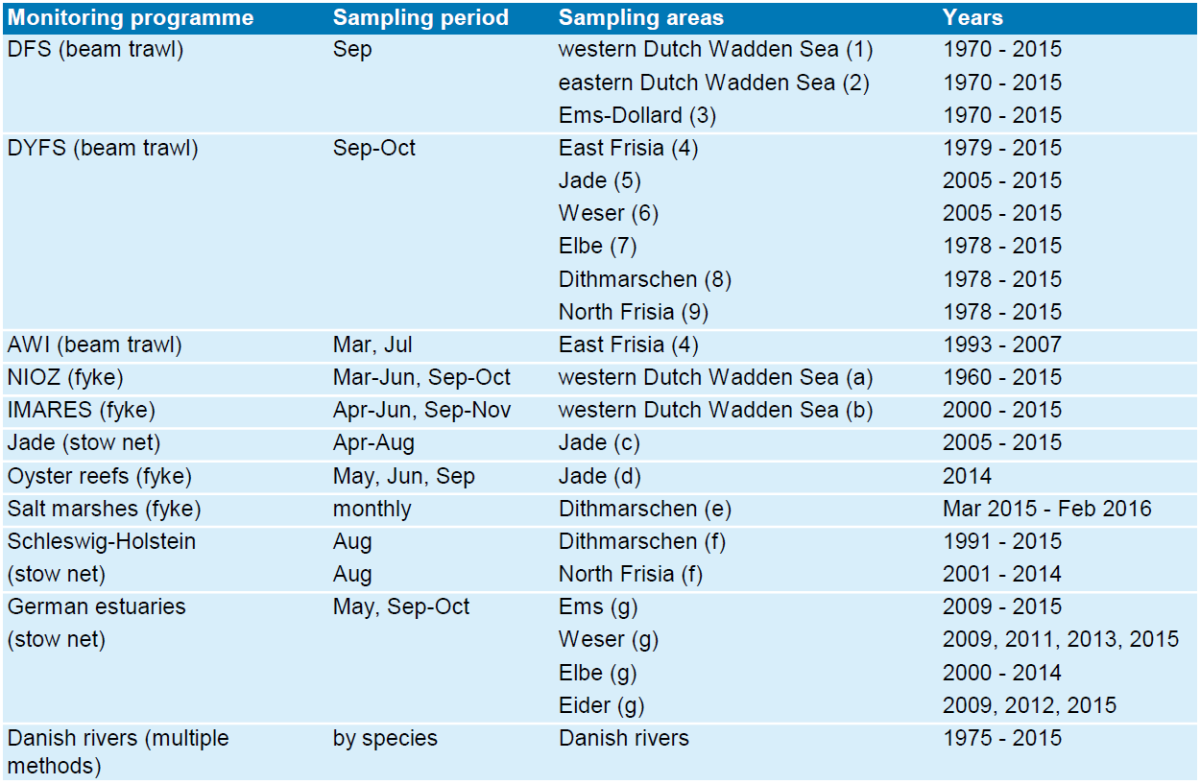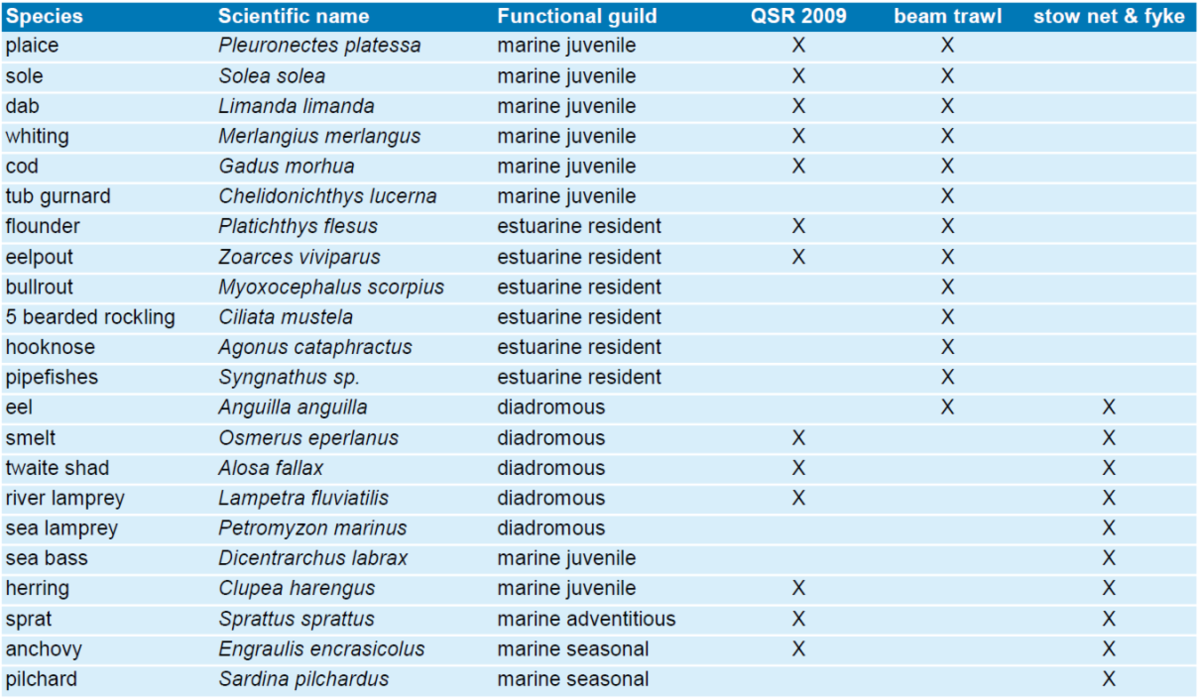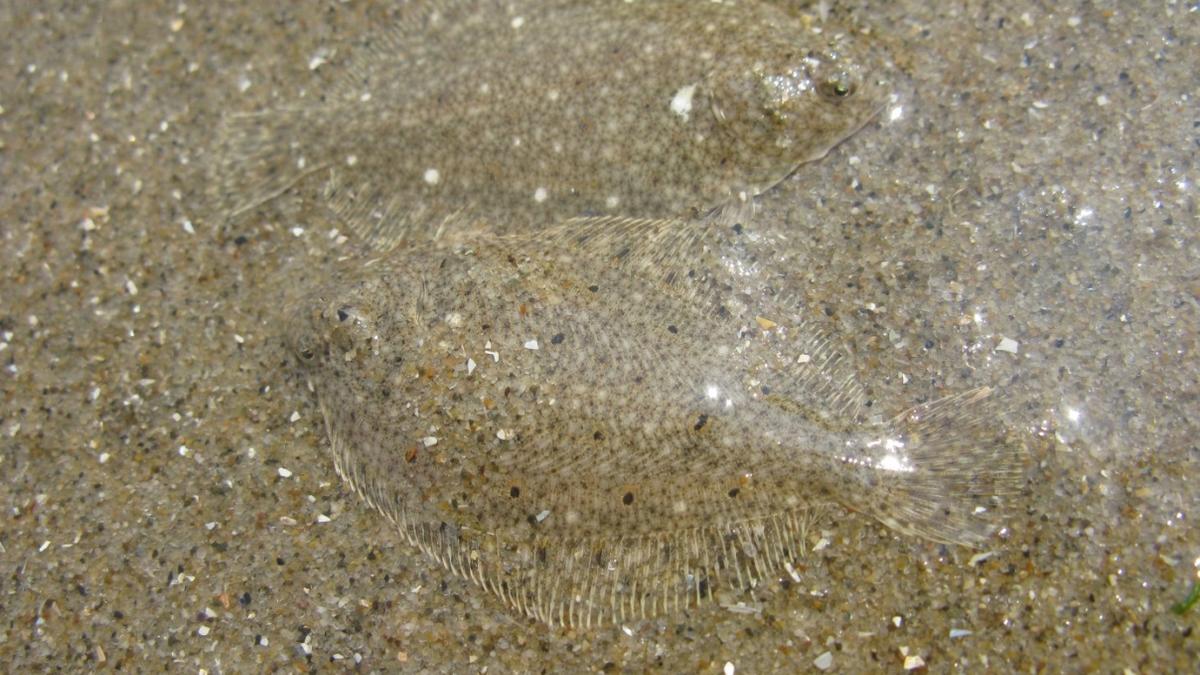
Photo: Robbert Jak/ IMARES. Two young plaice hiding on top of the sediment.
Fish
I. Tulp, L.J. Bolle, A. Dänhardt, P. de Vries, H. Haslob, N. Jepsen, J. Scholle, H.W. van der Veer
PDF1. Introduction
The shallow coastal Wadden Sea is an important area for many fish species (Figure 1). The Wadden Sea forms the transition between the estuaries and the North Sea. The inner Wadden Sea is connected with several estuaries, which are characterized by a pronounced salinity gradient. The outer Wadden Sea, demarked by the Frisian islands, is connected with and influenced by the North Sea.
Many fish species rely on the Wadden Sea for at least one of their life stages (Figure 2). A suite of marine fish (flatfish, other groundfish and pelagic fish species) reach the Wadden Sea as post-larvae and spend their juvenile phase there, benefitting from the high food availability and shelter from predators characteristic of the Wadden Sea (marine juveniles) (van der Veer et al., 2000; Elliott et al., 2007). Other species inhabit the region en route to either marine or fresh water spawning sites (diadromous species), during certain times of the year (marine seasonal migrants) or only occasionally (marine adventitious species) (Elliott et al., 2007). Apart from the temporary visitors, the Wadden Sea is also inhabited by resident species that spend (almost) their entire life in the Wadden Sea.
Fish species occurring in the Wadden Sea have been listed previously (e.g., Witte and Zijlstra, 1978; Bolle et al., 2009). In this report, focus is set on the status and trends of selected fish species, typically found in the Wadden Sea. Given that the trilateral fish targets are described in an abstract manner and, therefore, cannot be evaluated quantitatively, this QSR-contribution will be restricted to describing and classifying trends in a selection of species and functional groups.
 Figure 1. Fishing boat in the Wadden Sea (Photo: Ingrid Tulp, IMARES).
Figure 1. Fishing boat in the Wadden Sea (Photo: Ingrid Tulp, IMARES).
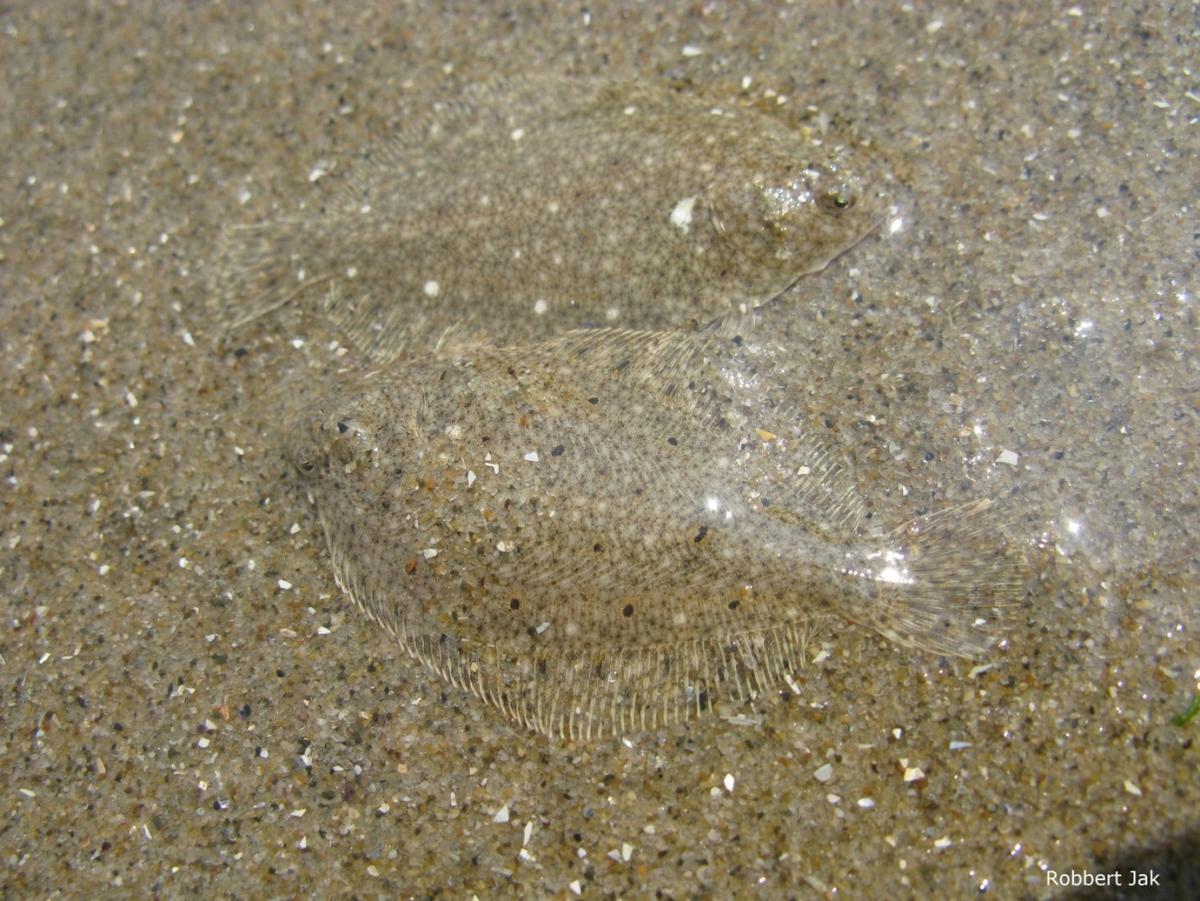 Figure 2. Two young plaice hiding on top of the sediment (Photo: Robbert Jak, IMARES).
Figure 2. Two young plaice hiding on top of the sediment (Photo: Robbert Jak, IMARES).
2. Status and trends
2.1 Overview monitoring programmes
Data from several fish monitoring programmes was used to examine the status and trends of fish utilising the Wadden Sea (Annex 1, Table 1, Figure 3 for Wadden Sea areas proper, Figure 4 for Danish rivers).
Table 1. Overview of fish monitoring programmes included in the QSR report. The sampling areas are depicted in Figure 3.
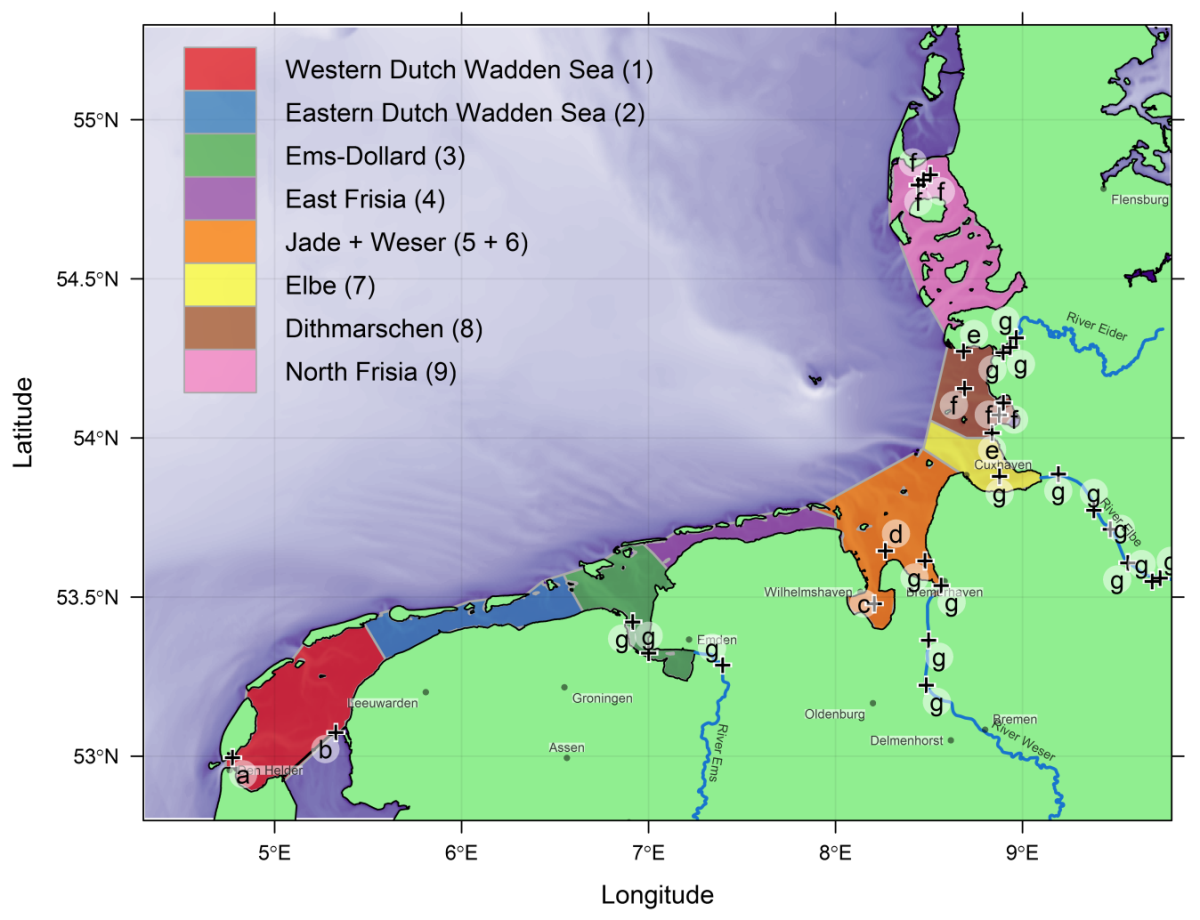 Figure 3. Map of the areas covered by the beam trawl surveys (numbered regions, see Table 1) and the sampling locations of fixed gears (positions indicated with + and labelled with a letter, see Table 1).
Figure 3. Map of the areas covered by the beam trawl surveys (numbered regions, see Table 1) and the sampling locations of fixed gears (positions indicated with + and labelled with a letter, see Table 1).

Figure 4. Map of the main Danish Wadden Sea rivers (names in boxes, Å means river in Danish) included in the Danish freshwater monitoring programmes.
2.2 Standardised trend analyses for selected species
Standardised trend analyses were carried out for selected species in all three beam trawl surveys (DFS, DYFS and AWI) and most of the stow net and fyke monitoring programmes (NIOZ, IMARES, Jade, Elbe and Schleswig-Holstein) (Figures 5, 6, 7, 8). The methods are described in Annex 2 and the results are presented in sections Annex 3 (beam trawl surveys) and 2.4 (fyke and stow net monitoring). This approach was not suitable for the rest of the monitoring programmes, mainly because of limited time series. The results of the remaining monitoring programmes are presented in sections 2.5 (German estuaries), 2.6 (Danish rivers) and 2.7 (salt marshes and oyster reefs).
In the previous QSR report on fish, 14 selected species were included in standardised trend analyses (Jager et al., 2009). The selection of these “priority” species was based on ecological criteria (ecological guild, habitat preference), relevance for management (Habitat Directive (HD) species or species belonging to the characteristic fish fauna of HD habitat types, Water Framework Directive (WFD) species, endangered or vulnerable species, food for birds or marine mammals), potential sensitivity to driving forces (climate change, nutrient enrichment, habitat degradation, fishing mortality and local pressures) and monitoring criteria (abundance, occurrence and catchability in the ongoing monitoring programs) (Bolle et al., 2009; Jager et al., 2009).
All previously selected species were included in the current standardised trend analyses, except sandeel (Ammodytes sp.), because sandeels are difficult to monitor quantitatively in any of the deployed gears. Additional species were included for specific reasons: eel and sea lamprey (endangered); sea bass, tub gurnard and pilchard (Lusitanian species); pipefishes (association with eelgrass beds); bullrout, five-bearded rockling and hooknose (to increase the proportion of estuarine residents in the selection). The most suitable gear (either beam trawl or fyke and stow net) was chosen for each species, except for eel in which case all time-series were used (Table 2).
Table 2. Fish species selected for standardised trend analysis.
2.3 Selected Wadden Sea fish species - beam trawl surveys
The beam trawl surveys (Figure 5, Figure 6) revealed a general decline among marine juvenile species since the 1980s, uniformly across all areas (Annex 2). As an exception tub gurnard increased in nearly all areas since 2000. Trends in estuarine resident species were much more variable, both between areas and species (for trend plots see Annex 3).
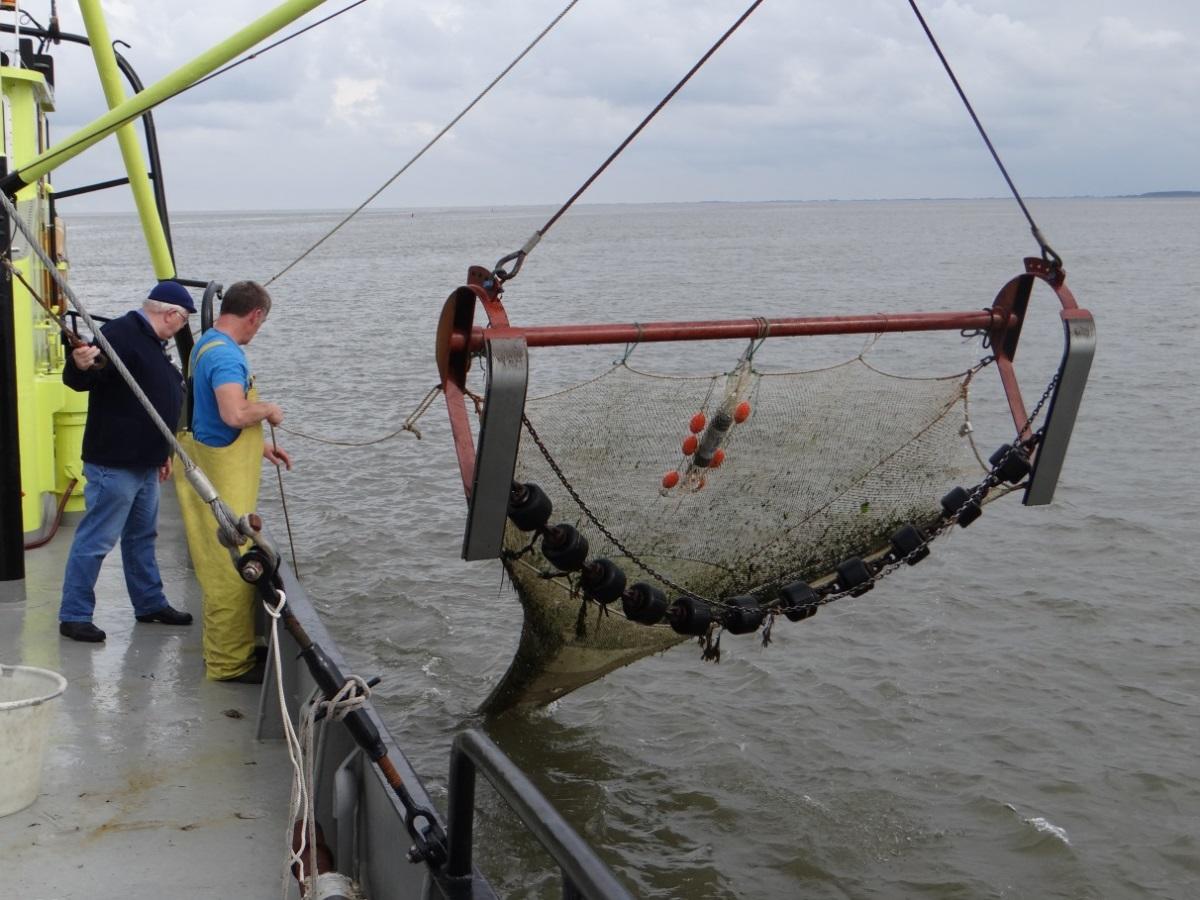 Figure 5. The 3 m beam trawl deployed in the Dutch Demersal Fish Survey (Photo: Ingrid Tulp, IMARES).
Figure 5. The 3 m beam trawl deployed in the Dutch Demersal Fish Survey (Photo: Ingrid Tulp, IMARES).
Marine juveniles and estuarine residents
Species were grouped to illustrate trends by functional guilds. Marine juveniles declined since the 1980s in all areas and surveys, with exception of the Weser and the AWI survey in East Frisia. Trends in estuarine species were more variable across areas and surveys (see Annex 3).
Pleuronectes platessa -plaice
Plaice declined in most areas and surveys since the 1980s. Exceptions were the Weser, Elbe and AWI survey in East Frisia, for which no clear trends were observed. In the period 1970-1980, plaice densities increased in the Dutch Wadden Sea and Ems-Dollard. The other areas were not surveyed in this period.
Solea solea - sole
Sole declined throughout the Wadden Sea and the survey periods, with exception of the AWI survey (increase) and the eastern Dutch Wadden Sea (slight recovery since 2000).
Limanda limanda - dab
Of all marine juvenile species, dab showed the strongest declines. Since the 1980s, dab declined in most areas and surveys. Exceptions are the Jade, Weser and the AWI survey, in which dab abundances were highly variable with no significant trend.
Merlangius merlangus - whiting
In most areas the trends were uncertain. Only in the western and eastern Dutch Wadden Sea and in the DYFS survey in East Frisia, periods with moderate to strong decreases occurred since the 1980s.
Gadus morhua - cod
Cod showed a negative trend in all areas and surveys from 1980 onwards, with exception of the AWI beam trawl survey. A peak was observed in the period between 1975 and 1980 in the DFS, data from other surveys were not available for this period.
Chelidonichthys lucerna - tub gurnard
In several areas, tub gurnard recently increased (since 2000).
Platichthys flesus - flounder
Flounder trends are either stable (eastern Dutch Wadden Sea, Elbe), increasing (Ems-Dollard, AWI survey) or uncertain (other areas).
Zoarces viviparus - eelpout
The trend in most areas is declining, either throughout the entire period or in shorter periods. The trend is uncertain in the Jade, Weser and AWI survey.
Myoxocephalus scorpius - bullrout
The trends varied between regions: stable (western Dutch Wadden Sea), increasing in the 1970s (eastern Dutch Wadden Sea and Ems-Dollard), decreasing in the 1980s followed by an uncertain trend or slight increase (eastern Dutch Wadden Sea, Ems-Dollard, Elbe), an overall increase (East Frisia, Dithmarschen and North Frisia).
Ciliata mustela - five bearded rockling
Trends for five-bearded rockling were either stable (eastern Dutch Wadden Sea), increasing (Elbe) or uncertain (all other areas).
Agonus cataphractus - hooknose
Hooknose trends were uncertain in all areas. In several areas there was a tendency of higher values in the 1980-1990s followed by a decline and, in some areas, an increase after 2005.
Syngnathus sp. - pipefishes
Pipefishes showed either (periods with) increasing or uncertain trends in all areas.
Anguilla anguilla - eel
Eel was only caught regularly in the Dutch Wadden Sea and Ems-Dollard, but declined in the last decades and is currently practically absent (apart from few incidental catches).
Figure 6. A beam trawl catch in the western Dutch Wadden Sea (Photo: Ingrid Tulp, IMARES).
2.4 Selected Wadden Sea fish species - fyke and stow net monitoring
Apart from the NIOZ fyke (operated since 1960) (Figure 7), the time-series of the fyke and stow net programmes were relatively short, limiting the potential to draw conclusions on long-term changes. Sea lamprey (Figure 8), sea bass and pilchard were only caught in the fykes in the western Dutch Wadden Sea, while river lamprey was caught at all locations except in the NIOZ fyke.
Eel showed a clear decline, consistent across all areas. Sea bass, a southerly species, increased in the western Wadden Sea between 1980 and 2000 and has levelled off since. Trends in the other species were mostly uncertain or different between areas (and survey periods) (compare trend plots in Annex 3).
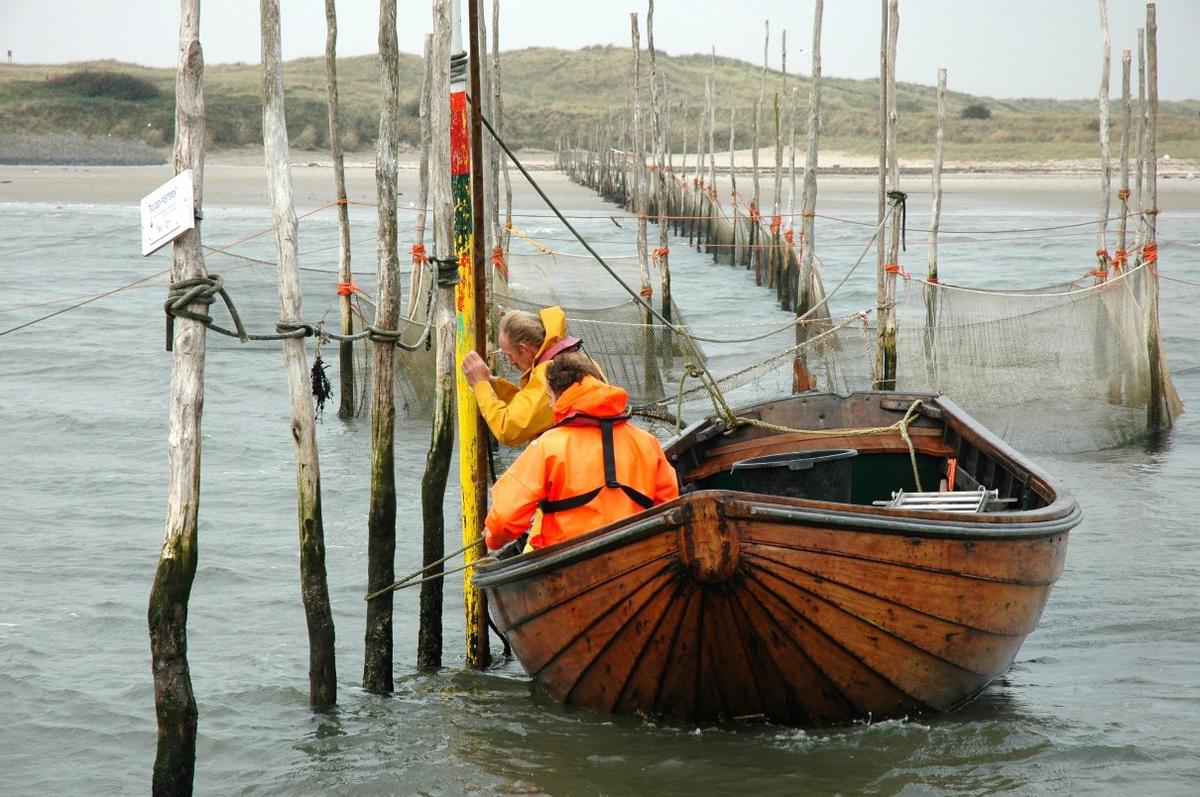
Figure 7. Daily emptying of the NIOZ fyke at the southern tip of Texel in the western Dutch Wadden Sea (Photo: Henk van der Veer, NIOZ).
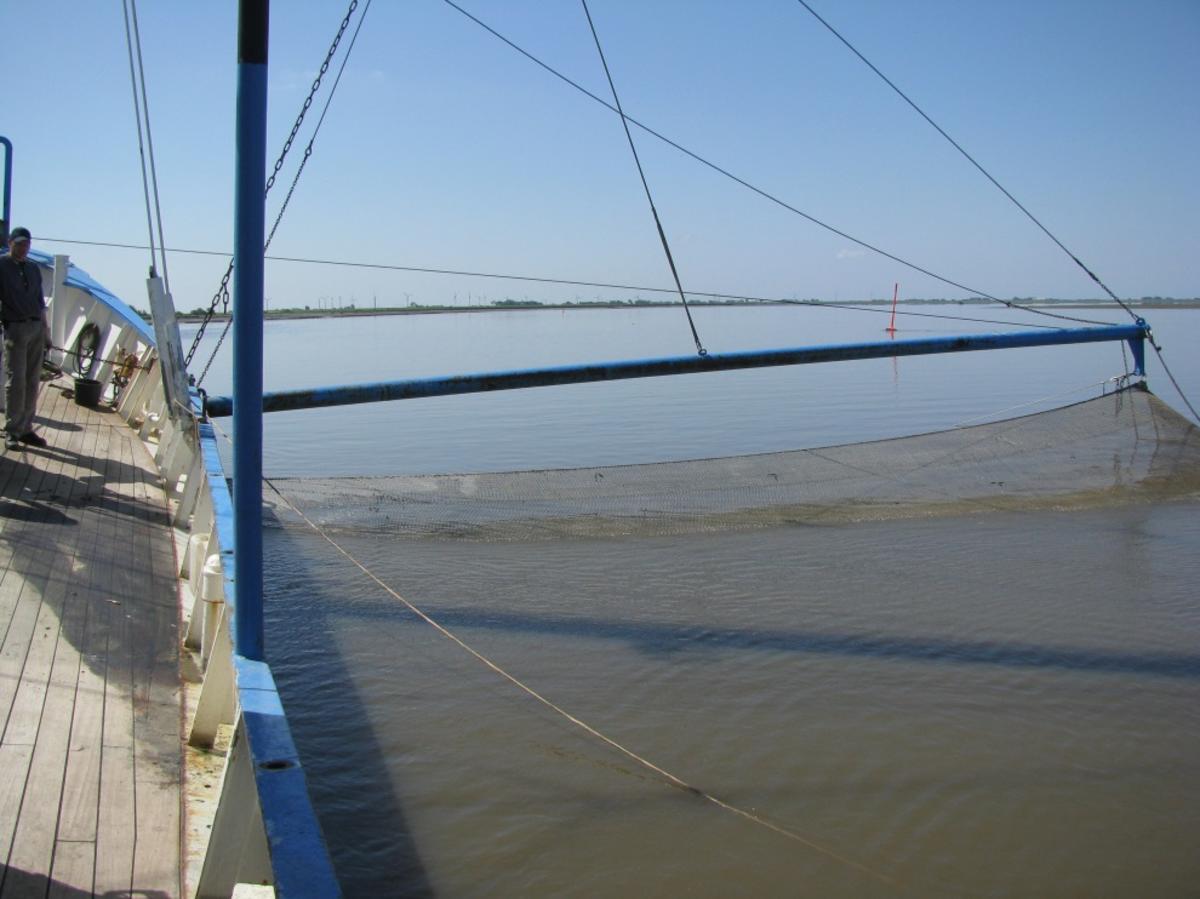 Figure 8. Stow net fishery on the Ems estuary (Photo: S. Schulze, Bioconsult).
Figure 8. Stow net fishery on the Ems estuary (Photo: S. Schulze, Bioconsult).
Anguilla anguilla – eel
The NIOZ fyke showed a clear and steady decline throughout the time-series. Even though the other monitoring programmes started much later, the decline is still apparent in these time-series. Current densities are (close to) zero in four out of six areas.
Osmerus eperlanus – smelt
The Jade stow net showed a (non-significant) decrease for adult smelt (June catches) and no clear trend for juveniles (August), while juveniles peaked around 2010 in Dithmarschen and increased since 2000 in North Frisia. In the western Dutch Wadden Sea, catches of both adults (May) and juveniles (September) were highly variable.
Alosa fallax - twaite shad
In the NIOZ fyke, adult twaite shad (May) increased in the 1970s, decreased in the 1980s and showed an uncertain trend since. Trends were uncertain in all other time-series with recent recruitment failures in the Jade area (August).
Lampetra fluviatilis - river lamprey
River lamprey was not caught in the NIOZ fyke. In the other time series they declined but the trends were classified as uncertain, except for a short period around 2005 in the IMARES fyke.
Petromyzon marinus - sea lamprey
Sea lamprey was occasionally caught in the NIOZ fyke before 1985 and since 2010. It was caught more frequently in the IMARES fykes with no clear trend over time. It was (almost) absent in all other programmes (Sea lamprey: Figure 8).
Dicentrarchus labrax - sea bass
Sea bass was only caught in the fykes. In the NIOZ fyke, sea bass showed an increasing trend from the late 1980s until the mid-2000s and an uncertain trend in other periods. The trend was uncertain in the IMARES fykes.
Clupea harengus - herring
In the NIOZ fyke, herring showed a significant increase from the late 1970s until the mid-1980s and uncertain trends in other periods. In the Elbe estuary, herring significantly increased from 2000 onwards. The trends in all other time-series were variable or uncertain.
Sprattus sprattus - sprat
In the NIOZ fyke, sprat increased in the period 1960-1980, showed no clear trend from 1980-2000 and decreased from 2000 onwards. A decrease from 2000-2008 was observed in Dithmarschen. The trends in all other time-series were uncertain.
Engraulis encrasicolus - anchovy
Anchovy catches were highly variable and trends were uncertain in all time-series.
Sardina pilchardus - pilchard
Pilchard was only caught in the fykes. Catches were highly variable and trends were uncertain in both time-series.
 Figure 9. Sea lamprey (Photo: Ingrid Tulp, IMARES).
Figure 9. Sea lamprey (Photo: Ingrid Tulp, IMARES).
2.5 Diadromous fish in German estuaries
Eight diadromous species were observed more or less regularly in German estuaries. For most of these species, the estuaries act as a migration corridor from the Wadden Sea to their spawning grounds in the upper reaches of the rivers (Table 3) (for trend plots see Annex 3).
Table 3. Recordings of diadromous species in the Ems, Weser, Elbe and Eider.
To illustrate the status and trends of diadromous species we focused on smelt and twaite shad, since estuaries fulfill multiple ecological functions for these two species: spawning, nursery and feeding grounds. Smelt spawns in the freshwater section of the estuaries and twaite shad spawns in the lower freshwater and upper oligohaline section of the estuaries.
Osmerus eperlanus - smelt
Compared to historical information (end of the 19th century), the current smelt numbers in the German estuaries are significantly lower, except for the Eider and to a lesser extent the Elbe (Scholle & Schuchardt, 2012). There are large differences between the estuaries. The lowest catch numbers were recorded in the Ems. Since the onset of monitoring in German estuaries, smelt catches showed no clear trend in the Elbe, Eider and Weser, whereas juveniles recently declined in the Ems.
Alosa fallax - twaite shad
Twaite shad (Figure 10) stocks substantially declined since the end of the 19th century (Schuchardt et al., 1985; Scholle & Schuchardt, 2012). At present, the situation varies greatly between estuaries. The estuaries of the Ems and Eider are of no significance for twaite shad nowadays. Twaite shad regularly occur in the Weser and reproduce there successfully, without clear trends in the recent past. The Elbe estuary contributes most to twaite shad numbers and reproduction in German estuaries. In contrast to the other Wadden Sea estuaries, numbers in the Elbe appeared to be increasing in recent years. Against this background the Red List status of the twaite shad for the North Sea was recently changed from critically endangered to “early warning” (early warning list, Thiel et al., 2014).
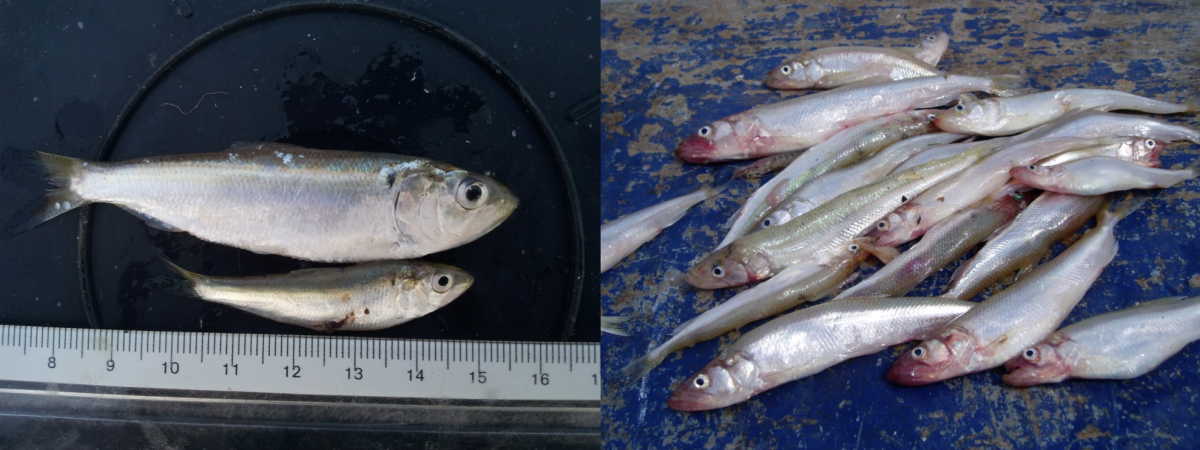 Figure 10. Left (A): Twaite shad (Alosa fallax) adult (above) and juvenile (below) caught in the Weser; Right (B): Smelt (Osmerus eperlanus) caught in the Weser (Photos: S. Schulze, Bioconsult).
Figure 10. Left (A): Twaite shad (Alosa fallax) adult (above) and juvenile (below) caught in the Weser; Right (B): Smelt (Osmerus eperlanus) caught in the Weser (Photos: S. Schulze, Bioconsult).
2.6 Diadromous fish in Danish rivers
Salmo salar - salmon
From being almost extinct in the 1980s, the Danish stocks of Atlantic salmon had a very strong rebound in most western rivers. Originally, nine rivers in Denmark harboured salmon, of which eight were situated on the west coast of Jutland from Storå and down to the German border (salmon: Figure 11).
Using a mark-recapture approach the number of adult salmon entering the Danish rivers are calculated. A high number of fish are caught (by electrofishing), tagged (PIT) and released. Then a week or two later, most of the river system is again fished and based on the recaptures a solid estimate can be made and the 95 % probability calculated.
Thus, of the Wadden Sea rivers, the Ribe was surveyed in 2012 and the number of adult spawners was 908 (95 % probability: 645-1171), River Varde was surveyed in 2012 (874 +/- 200), 2014 (1596 +/- 180) and 2016 (3389 +/- 320).
Sneum Å was surveyed in 2015 and had a spawning run of 1108 (1006 – 1209). Approximately two third of the fish were wild. Varde å was surveyed in 2012 and 2014. In 2012 the number was 874 (95 % prob.670-1050). In 2014 the number was 1596 (95 % prob. 1413-1779). The distribution between hatchery and wild fish is not known yet, but we are confident that more than 50 % are of wild origin. Salmon in the Sneum River were monitored for the first time in 2015, resulting in 1108 individuals (1006 – 1209), of which one third was from hatchery origin. The status for salmon is very good and the trend is upward. Stocking is being phased out.
Salmo trutta - sea trout
All the Danish streams and rivers flowing into the Wadden Sea have populations of sea trout. Most of these are indigenous populations, despite many decades of stocking. Ribe å, Sneum å and Kongeå have strong runs of very large (5-11 kg) sea trout. Even in Brede å and Varde å, anglers catch several hundred sea trout annually. Now stocking is decreasing and the general trend has been increasing stocks.
Coregonus oxyrinchus - North Sea houting
This rare fish is at very high risk of extinction. Despite large river restoration projects aimed at protecting the North Sea houting, the populations in Ribe and Varde å have almost disappeared. Today, the only viable population is found in the Vidå, where the estimated number of spawners is approx. 1000.
Angilla anguilla - eel
The European eel is globally threatened, also in the Wadden Sea area. The recruitment of glass eels is only a few percent of earlier levels. A small increase/recovery was noted in 2011-2015 on monitoring stations in Denmark, but the one station in the Wadden Sea area has shown no such trend. The population status is very low and there is no sign of substantial recovery. The outmigration of silver eels from the Ribe å is quite low (less than four tonnes per year) and has shown no clear trend.
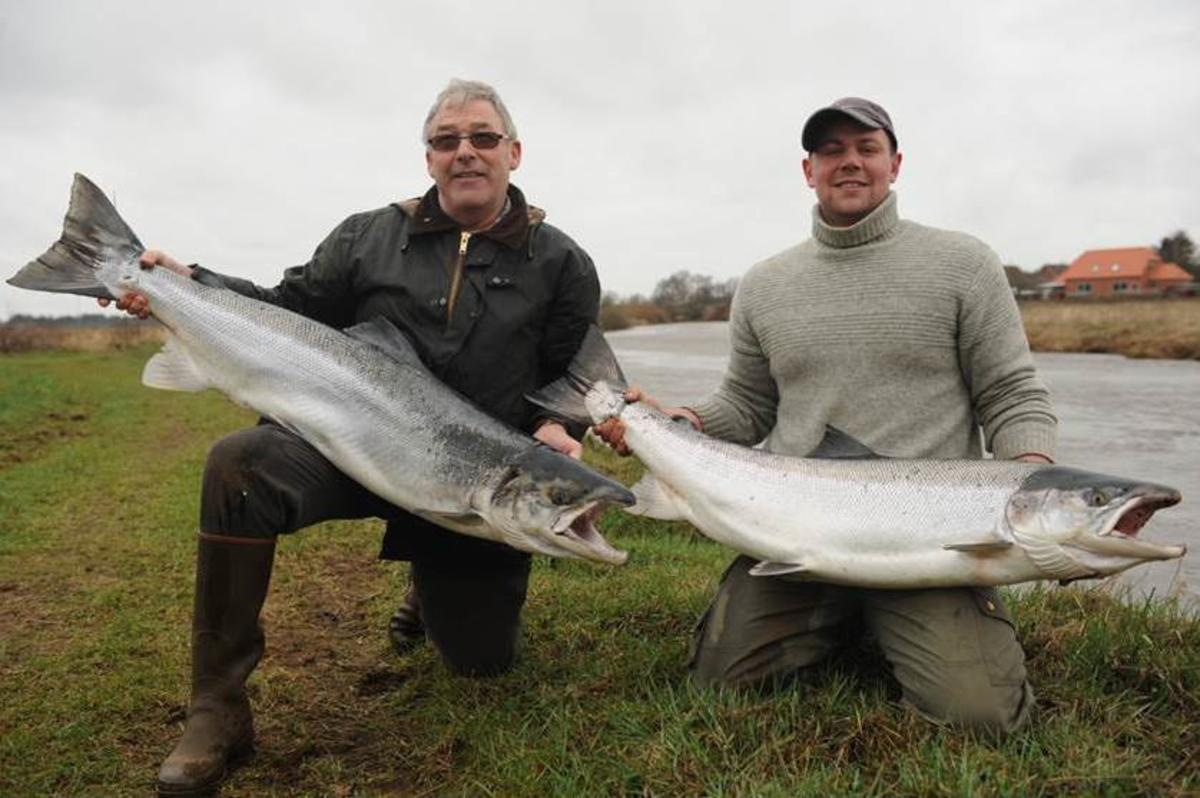 Figure 11. Salmons (Salmo salar, approx. 18 kg each) caught on the Varde å in April (photo: Niels Jepsen, DTU Aqua).
Figure 11. Salmons (Salmo salar, approx. 18 kg each) caught on the Varde å in April (photo: Niels Jepsen, DTU Aqua).
2.7 Fish in specific habitats: salt marshes and oyster reefs
One of the recommendations of the last QSR, namely fish occurrence in specific habitats, has been addressed by new investigations in Germany (Jager et al., 2009). The Wadden Sea hosts species and life stages closely associated with physical habitats inaccessible to standard monitoring gear. To supplement results from established fish surveys, we deployed stationary fyke nets on a Pacific oyster reef and in intertidal saltmarsh creeks (Figure 12) to investigate if and how fish utilize these specific habitats.
Between March 2015 and February 2016, 78 hauls yielded fourteen fish species from intertidal salt marsh creeks off Ehstensiel (Eider estuary, Schleswig-Holstein Wadden Sea). Common gobies were numerically dominant year-round, but with substantial changes in seasonal abundance of larvae, juveniles and adults. Similarly, herring, three-spined stickleback and Nilsson’s pipefish were dominant and exhibited seasonal occurrence patterns. Juvenile herring were most abundant in summer and winter, adult and juvenile stickleback in spring and winter and adult and juvenile pipefish in spring and winter. The remainder of species were caught in much lower numbers. A few of them were underrepresented in standard surveys, e.g., thick-lipped mullets and nine-spined stickleback.
These results were only partly consistent with findings from 35 hauls made between fall 2010 and late summer 2011 (no data in winter) in the salt marsh creeks in Dieksanderkoog Nord (Dithmarschen, Schleswig-Holstein Wadden Sea), located about 30 km further south. The seasonal abundance patterns of three-spined stickleback and Nilsson’s pipefish were similar in both marshes, whereas herring was caught mainly in spring in Dieksanderkoog Nord. Gobies dominated only in fall. In late summer, large numbers of juvenile twaite shad entered the creeks, ascending as far up as 1.3 km from the creek mouth. Not a single specimen of these diadromous pelagics where found in the marsh off Ehstensiel.
Insight into habitat use around an oyster reefs was gained from the combination of different sampling methods. Proportions of fish found on a Pacific oyster reef at Kaiserbalje (Jade, Lower Saxon Wadden Sea) differed between small gullies draining the reef surface and larger creeks surrounding the reef: Common gobies dominated the reef surface over plaice and sand goby, which, in turn, were much more abundant in the surrounding creeks. As expected, pelagic fish such as herring, Nilsson’s pipefish and smelt dominated the stow net catches (carried out for reference), but were only occasionally caught on or near the reef.
These dedicated research projects on specific habitats provided useful insights into the importance of salt marsh creeks and oyster beds for several fish species, including rarer (endangered) species that may go unnoticed in the standard surveys. The results of such projects deliver basic knowledge on seasonal habitat requirements of fish, such as spawning and nursery habitat. This knowledge is needed in order to evaluate the value of different habitats in the life cycle of Wadden Sea fish species.
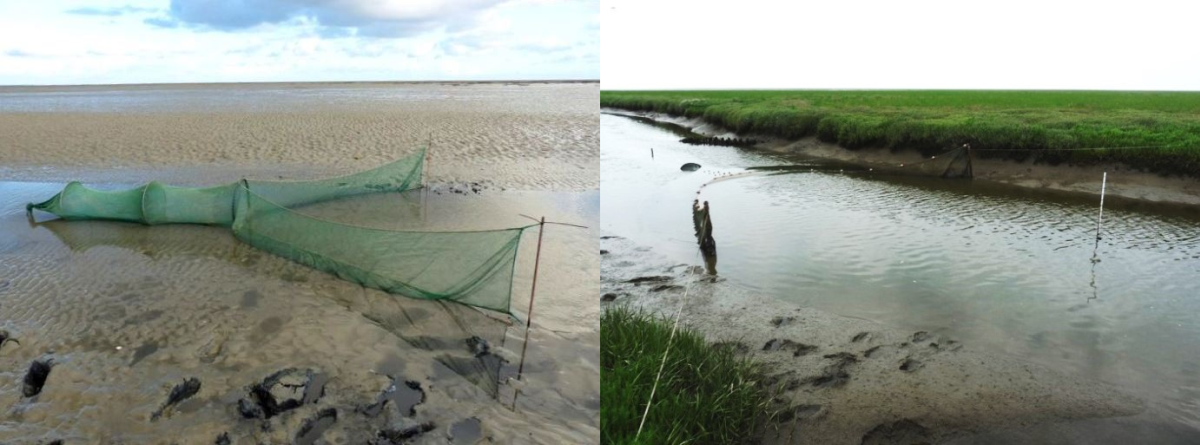 Figure 12. Left (A): Fyke nets positioned in creeks draining an intertidal Pacific oyster reef (Kaiserbalje, Lower Saxon Wadden Sea); Right (B): A salt marsh in Dieksanderkoog Nord (Dithmarschen, Schleswig-Holstein Wadden Sea) (Photos: Andreas Dänhardt, University of Hamburg).
Figure 12. Left (A): Fyke nets positioned in creeks draining an intertidal Pacific oyster reef (Kaiserbalje, Lower Saxon Wadden Sea); Right (B): A salt marsh in Dieksanderkoog Nord (Dithmarschen, Schleswig-Holstein Wadden Sea) (Photos: Andreas Dänhardt, University of Hamburg).
2.8 Potential drivers
For many of the species reported here, basic information on their habitat requirements, habitat use, seasonal migrations and physiological requirements in the Wadden Sea is lacking. Underlying mechanisms have only been studied for a small number of species. Candidate factors often mentioned are climate change, fisheries, reduced connectivity, habitat deterioration, nutrient dynamics and increased predation pressure (see reports on climate change, climate ecology, fisheries, eutrophication).
The decline of juvenile plaice in the Wadden Sea has been shown to be related to a change in growth potential in the coastal region (Teal et al., 2012) due to the warming seawater and food limitation in summer. Pörtner & Knust (2007) showed that the decline in eelpout in German coastal waters was likely linked to an increase of water temperatures above the thermal maximum for the species, leading to oxygen limitation. Eelpout also largely retreated from the more inshore regions covered by offshore surveys (Heessen et al., 2015).
The shrimp fisheries is the most important fisheries in the Wadden Sea and coastal regions and use the region intensively (ICES, 2015). The bycatch of small fish in this fisheries (with small mesh sizes of 20 mm) is relatively large and has been calculated as potentially reducing the spawning stock biomass of plaice by 12-17 % (van der Hammen et al., 2015). From 1990 to early this century the international shrimp fisheries nearly doubled in terms of tonnes landed.
The decline in juvenile smelt in the Ems is possibly due to extreme quantities of suspended matter (fluid mud) and oxygen deficiency in the inner parts of the estuary. These adverse environmental conditions also prevent successful reproduction of twaite shad in this potential spawning area. The reasons for the absence of adult twaite shad in the Eider are currently still unclear, though presumably the spatially changing and very steep salinity gradient play a role.
The reduction in nutrients after the mid 1980s coincides with the steepest decline in especially marine juvenile species. Whether or not this is a causal relation has been subject of many discussions, but is as yet unresolved (Stottrup et al., in press). Clearly this aspect needs to be viewed in light of the carrying capacity of the system and the question whether or not food is limiting.
In Danish Wadden Sea rivers, diadromous fish in general have benefitted from the removal of dams along the river. Currently the major threat for salmon is cormorant predation of juveniles in winter and during smolt run in spring (Figure 13). Sea trout in Danish rivers has benefitted very much from the restrictions on net fishing. The major problem now is suboptimal spawning habitat (sediment transport due to intensive agriculture) and cormorant predation. Despite large river restoration projects, North Sea houting has almost disappeared from Danish rivers. Also for North Sea houting, cormorant predation seems to be an important threat.
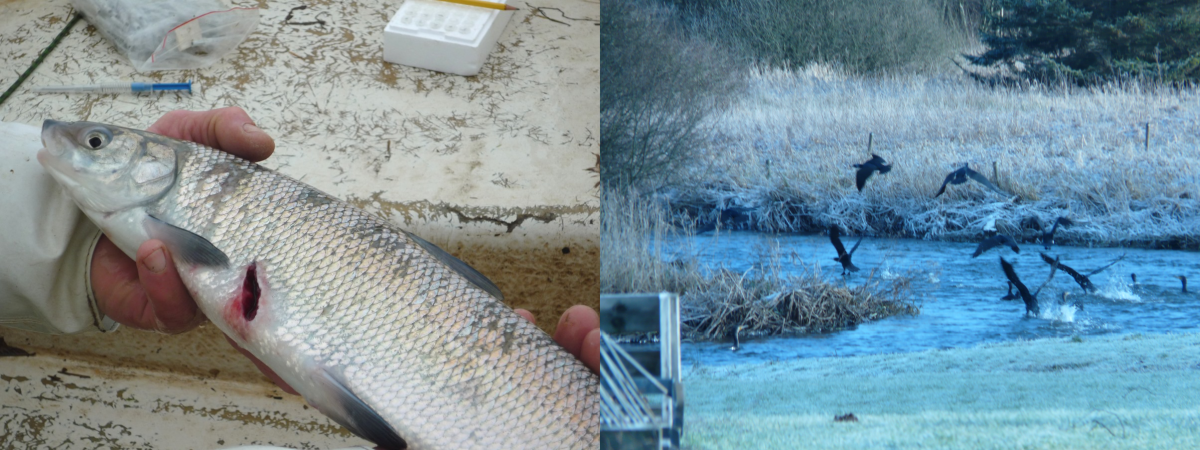 Figure 13. Left (A): North Sea houting with wounds, probably caused by cormorant attacks; Right (B): Cormorant attacks (Photos: Niels Jepsen, DTU Aqua).
Figure 13. Left (A): North Sea houting with wounds, probably caused by cormorant attacks; Right (B): Cormorant attacks (Photos: Niels Jepsen, DTU Aqua).
The suite of potential factors underlying the observed trends and especially the decline of the marine juveniles also include factors such as habitat change (dynamics in the availability of mussel beds and eelgrass fields), sand nourishments along the coast and North Sea fisheries on adult populations. In several studies correlations between such factors and fish trends were explored but cannot satisfactorily pinpoint the cause of observed trends (Tulp et al., 2008; van der Veer et al., 2015). To identify drivers for developments for certain species, a species specific approach is necessary in which knowledge on physiological and habitat requirements are crucial.
3. Assessment
The Wadden Sea is protected by national legislation (such as the National park laws in Germany), EU Directives (Habitats, Water Framework and Marine Strategy Framework Directives) and international policy agreements (such as the UNESCO Man and biosphere and world heritage programmes and the OSPAR, Bern and Bonn conventions). Each of these has its own policy objectives that were summarised in Walker (2015).
The following fish targets were formulated in the trilateral Wadden Sea Plan (CWSS, 2010):
- Viable stocks of populations and a natural reproduction of typical Wadden Sea fish species;
- Occurrence and abundance of fish species according to the natural dynamics in (a)biotic conditions;
- Favourable living conditions for endangered fish species;
- Maintenance of the diversity of natural habitats to provide substratum for spawning and nursery functions for juvenile fish;
- Maintaining and restoring the possibilities for the passage of migrating fish between the Wadden Sea and inland waters.
These targets were not formulated in a testable way, which makes it impossible to evaluate them quantitatively. Furthermore, the formulations are not all easy to comprehend, allowing multiple interpretations. To facilitate objective evaluation in the future, we propose to restructure and reformulate the targets as follows:
Overall target:
There should be no human-induced bottlenecks in the Wadden Sea for fish populations or their ecosystem functions.
Targets (all in reference to the overall target):
Maintain or improve:
- Robust and viable populations of estuarine resident fish species;
- The nursery function of the Wadden Sea and estuaries;
- The quality and quantity of typical Wadden Sea habitats;
- Passage ways for fish migrating between the Wadden Sea and inland waters;
- Conservation of endangered fish species.
Clarifications:
- Fish populations: we include species currently present, but also consider niches that are currently vacant (e.g., large predators), regardless of the species that used to fill these niches historically;
- Ecosystem functions: e.g., food for birds and mammals in the Wadden Sea;
- Maintain or improve: requires an evaluation beforehand;
- Robust: can withstand extreme events;
- Viable: self-sustaining;
- Diversity of habitats required for diversity of species and functions (e.g., spawning, nursery);
- Endangered: As evaluated by national red lists.
The next step is to formulate quantitative and testable sub-targets for each target. These sub-targets must focus on fish parameters that are influenced by (manageable) human activities. At this stage, knowledge on human impacts, population dynamics and ecology of typical Wadden Sea fish species is too limited to enable quantitative sub-targets. The recommendations on research (see below) aim at acquiring sufficient knowledge to enable setting such quantitative sub-targets in the future.
In contrast to the Wadden Sea, hard targets have been set for transitional waters (estuaries - see report on estuaries) and rivers under the EU Water Framework Directive (WFD). The WFD quality component “fish” is based on species richness and species-specific abundance in comparison to a defined reference. For coastal water types, the EU Water Framework Directive (WFD) does not require a fish-based assessment. For the North Sea, including its coastal waters, an assessment of fish is required to meet the demands of the Marine Strategy Framework Directive (MSFD). Assessment approaches are under discussion and not finalized. In the conservation objectives for fish species which are relevant in the frame of the Habitat Directive (shad, lampreys and in regard to habitat types “typical species”), the conservation goal “good status” is amongst other criteria (good habitat quality, minor impairments) associated with population parameters (e.g., “high abundances”; species specific).
4. Recommendations
Management
- Stronger support from national governments for fish research. Compared to other more visible and ‘charismatic’ groups such as birds, research on fish is heavily underrepresented and mainly focussed on surveys (rather than research on mechanisms) and on commercial (demersal) species;
- Consider that the Wadden Sea is an important (and perhaps critical) area within the entire chain of areas that fish need to complete their life cycle;
- Long-lasting trilateral projects are needed to catch up with this backlog;
- Facilitate integrated monitoring of fish as part of the food web. Fish is an important component of the food web as food for birds and sea mammals and as predator of benthos and lower trophic levels;
- Management of the Wadden Sea should be at (inter)national levels instead of provinces;
- Exploring the possibilities of citizen science (as currently in practise in daily emptying of the NIOZ fyke) or cooperation with fishermen could enhance research effort;
- Map quality and quantity of typical Wadden Sea habitats ( salt marshes, shellfish reefs, seagrass beds, mudflats, sandflats) to reconcile conservation with other stakes (spatial planning).
Research
Currently most research effort is directed at surveying local populations instead of building on knowledge on mechanisms influencing local populations. Future research should address functional relationships as well e.g.,:
- Species-habitat relationships: habitat quantity and quality;
- Predator (including fisheries)-prey relationships;
- Connectivity issues: at large (diadromous and marine migrations) and small (habitat mosaic, response to temperature) scales;
- Ecophysiology: optimal and critical ranges (e.g., temperature, salinity);
- Occurrence and role of pelagic species (most survey work is aimed at demersal species only).
Address methodological issues (trilaterally):
- Ecosystem modelling;
- New methods (E-DNA, telemetry, acoustics);
- Comparison of catch methods;
- Hydro-acoustics;
- Sandeel, mullet and other escapees that are not sampled well with the current methods;
- Catching efficiency of survey gear: for many applications relative densities are not sufficient; in food web work there is a need for absolute estimates of fish biomass.
Impact studies:
- Physical modification of habitats due to human impact
- Cumulative effects
- Shrimp fisheries impact on bycatch and the benthic community
- Cooling water extraction from the Wadden Sea (Eemshaven, Wilhelmshaven, Elbe estuary). Follow up on position paper on cooling water extraction from the Wadden Sea by Jager (2010)
Evaluation and application
- Develop criteria to distinguish between natural dynamics and human impacts;
- Identify anthropogenic sources of direct and indirect fish mortality and develop mitigation measures;
- Compile historical information to reconstruct the historical state and compare this with the present state on the basis of structure and function of the Wadden Sea ecosystem (so not on individual species basis);
- Use the historical situation (structure and function) as a basis for evaluating whether the current situation needs to be maintained or improved.
5. Summary
Trends in abundance of Wadden Sea fish varied between ecological guilds. Fish using the Wadden Sea as a nursery area have generally decreased since the 1980s, with exception of a few species and regions. The nursery function of the Wadden Sea has greatly declined for the traditional flatfish species such as plaice, dab and sole. In contrast, two newcomers to this guild (southern species) increased, tub gurnard in all areas and sea bass in the western Wadden Sea. For other migratory species and resident species, trends varied considerably between species, regions and time periods. Most noteworthy trends are the increase of salmon and decrease of North Sea houting in Danish Wadden Sea rivers and the overall decrease of eel in all regions and gears.
About the authorsI. Tulp1, L.J. Bolle1, A. Dänhardt2 P. de Vries1, H. Haslob3, N. Jepsen4, J. Scholle5, H.W. van der Veer6 1 Wageningen Marine Research, P. O. Box 68, 1970 AB IJmuiden, NL 2 Institute for Hydrobiology and Fisheries Science, University of Hamburg, Olbersweg 24, 22767, Hamburg, DE 3 Thünen Institute of Sea Fisheries, Palmaille 9, 22767 Hamburg, DE 4 DTU AQUA, National Institute of Aquatic Resources, Technical University of Denmark, Vejlsøvej 39, 8600 Silkeborg, DK 5 BIOCONSULT Schuchardt & Scholle GbR, Reeder-Bischoff-Straße 54, 28757 Bremen, DE 6 Royal Netherlands Institute for Sea Research, Department of Coastal Systems and Utrecht University, P.O. Box 59, 1790 AB Den Burg (Texel), NL |
AcknowledgementContributors to this report are J. Friese, R. Knust, A. Markert, C.J.M. Philippart, L. van Walraven, R. Vorberg, A. Wehrmann, J.IJ. Witte. |
References
Bolle L.J., Neudecker T., Vorberg R., Damm U., Diederichs B., Scholle J., Jager Z., Daenhardt A., Lüerßen G., Marencic H. (2009) Trends in Wadden Sea Fish Fauna. Part I: Trilateral Cooperation. Wageningen IMARES report C108/08.
Bolle L.J., Dickey-Collas M., van Beek J.K.L., Erftemeijer P.L.A., Witte J.IJ., van der Veer H.W., Rijnsdorp A.D. (2009) Variability in transport of fish eggs and larvae. III. Effects of hydrodynamics and larval behaviour on recruitment in plaice. Marine Ecology Progress Series 390: 195-211
Corten, A. (2002) The role of `conservatism' in herring migrations. Reviews in Fish Biology and Fisheries 11: 339-361.
CWSS (2010) Wadden Sea Plan. 11th Trilateral Governmental Conference on the Protection of the Wadden Sea, Westerland/Sylt 18 March 2010. Common Wadden Sea Secretariat (CWSS), Wilhelmshaven, Germany.
Dänhardt A. (2010) The spatial and temporal link between common terns Sterna hirundo and their prey fish in the Wadden Sea. PhD thesis Institute of Avian Research, Wilhelmshaven, 117 pages.
Dänhardt A. (2016) Meeresfische an der Jade. In: Oldenburger Landesverein für Geschichte, Natur- und Heimatkunde e.V. (OLV) and Biologische Schutzgemeinschaft Hunter Weser-Ems e.V. (BSH) (Eds.) Die Jade - Flusslandschaft am Jadebusen. Landes- und naturkundliche Beiträge zu einem Fluss zwischen Moor, Marsch und Meer. Isensee Verlag Oldenburg ISBN 978-3-7308-1075-0.
Dänhardt A., Becker P.H. (2008) Die Bedeutung umweltbedingter Verteilungsmuster von Schwarmfischen für Seevögel im Ökosystem Niedersächsisches Wattenmeer. Final report of the project 53-NWS-41/04 of the Niedersächsische Wattenmeerstiftung, Institute of Avian Research, Wilhelmshaven, 248 pages (in German).
Dänhardt A., Becker P.H. (2011) Herring and sprat abundance indices predict chick growth and reproductive performance of common terns breeding in the Wadden Sea. Ecosystems 14: 791-803.
Dänhardt A., Becker P.H. (2011) Does small-scale vertical distribution of juvenile schooling fish affect prey availability to surface-feeding seabirds in the Wadden Sea? Journal of Sea Research 65: 247-255.
de Vlas J. (1979) Annual food intake by plaice and flounder in a tidal flat area in the Dutch Wadden Sea, with special reference to consumption of regenerating parts of macrobenthic prey. Netherlands Journal of Sea Research 13: 117-153.
Dickey-Collas M., Bolle L.J., van Beek J.K.L., Erftemeijer P.L.A. (2009) Variability in transport of fish eggs and larvae. II. Effects of hydrodynamics on the transport of Downs herring larvae. Marine Ecology Progress Series 390: 183-194.
Dickey-Collas M., Heessen H.J.L., Ellis J. (2015) Shads, herring, pilchard, sprat (Clupeidae). In : Heessen H.J.L., Daan N., Ellis J. (Eds.) Fish atlas of the Celtic Sea, North Sea, and Baltic Sea. KNNV Publishing, Zeist, The Netherlands, p. 139-151.
Elliott M., Whitfield A.K., Potter I.C., Blaber S.J.M., Cyrus D.P., Nordlie F.G., Harrison T.D. (2007) The guild approach to categorizing estuarine fish assemblages: a global review. Fish and Fisheries 8: 241-268.
Freitas V., Witte J.IJ., Tulp I., van der Veer H.W. (2016) Shifts in nursery habitat utilization by 0-group plaice in the western Dutch Wadden Sea. Journal of Sea Research 111: 65-75.
Geffen A.J. (2009) Advances in herring biology: from simple to complex, coping with plasticity and adaptability. ICES Journal of Marine Science 66: 1688-1695.
Gröger J.P., Kruse G.H., Rohlf N. (2009) Slave to the rhythm: how large-scale climate cycles trigger herring (Clupea harengus) regeneration in the North Sea. ICES Journal of Marine Science 67: 454-465.
Harvey A.C. (1989) Forecasting, structural time series models and the Kalman filter, Cambridge University Press, Cambridge.
Heessen H.J.L., Daan N., Ellis J.R. (2015) Fish Atlas of the Celtic Sea, North Sea and Baltic Sea. KNNV Publishing, Zeist, The Netherlands.
ICES (2011) Report of the Working Group on Beam Trawl Surveys (WGBEAM), 7-10 June 2011, Hamburg, Germany. ICES CM 2011/SSGESST:14.
ICES (2015) Report of the Working Group on Crangon Fisheries and Life History (WGCRAN), 18-20 May 2015, IJmuiden, the Netherlands. ICES CM 2015/SSGEPD:07.
Jager Z., Bolle L., Dänhardt A., Diederichs B., Neudecker T., Scholle J., Vorberg R. (2009. Fish. Thematic Report No. 14. In: Marencic H. & de Vlas J. (Eds). Quality Status Report 2009. Wadden Sea Ecosystem No. 25. Common Wadden Sea Secretariat, Trilateral Monitoring and Assessment Group, Wilhelmshaven, Germany.
Jager Z. (2010. Position paper on the sustainable use of cooling water from the Wadden Sea. Wadden Academy-KNAW, Leeuwarden, The Netherlands.
Kalman R.E. (1960) A new approach to linear filtering and prediction problems. Transactions of the ASME D82: 95-108.
Knust R., Brodte E., Gautier M., Hoppe I., Isbert W., Koschnick N., Ulleweit J., et al. (2013) Counts and mass of different fish species from beam trawl samples in the East Frisian Wadden Sea during BUTT cruise BU0193, POLARIS cruises PO0100-0107, 0193-0207, 0293-0299, 0303, 0393-0398, 0493-0496, 0593-0595, 0693-0695, 0793 & 0794, 0893 & 0894, 0993, SARA MAATJE cruise SM0193 and SENCKENBERG cruises SE0193 & 0293. Alfred Wegener Institute, Helmholtz Center for Polar and Marine Research, Bremerhaven, dois: 10.1594/PANGAEA. 762094, 762206-762209, 762212-762230, 762235, 762237, 762239-762243, 762246, 762275-762297, 762300, 762302.
McQuinn I.H. (1997) Metapopulations and the Atlantic herring. Reviews in Fish biology and fisheries 7: 297-329.
Munk P., Christensen V. (1990) Larval growth and drift pattern and the separation of herring spawning groups in the North Sea. Journal of Fish Biology 37: 135-48.
Otto L., Zimmerman J.T.F., Furnes G.K., Mork M., Saetre R., Becker G. (1990) Review of the physical oceanography of the North Sea. Netherland Journal of Sea Research 26: 161–238.
Payne M.R., Hatfield E.M.C., Dickey-Collas M., Falkenhaug T., Gallego A., Gröger J., Licandro P., Llope M., Munk P., Röckmann C., Schmidt J. O., Nash R. D. M. (2009) Recruitment in a changing environment: The 2000s North Sea herring recruitment failure. ICES Journal of Marine Science 66: 1-6.
Polte. P., Asmus H. (2006) Intertidal seagrass beds (Zostera noltii) as spawning grounds for transient fishes in the Wadden Sea. Marine Ecology Progress Series 312: 235-243.
Portner H.O., Knust R. (2007) Climate change affects marine fishes through the oxygen limitation of thermal tolerance. Science 315: 95-97
Scholle J., Schuchardt B. (2012) A fish-based index of biotic integrity - FAT-TW an assessment tool for transitional waters of the northern German tidal estuaries.
Schareck A. (2013) Habitatqualität für Fische im Wattenmeer: Untersuchungen zu Ernährung, Kondition und Otolithen ausgewählter Arten. Master Thesis University of Hamburg, Institute for Hydrobiology and Fisheries Science, 110 pages.
Schuchardt B., Busch D., Schirmer M., Schröder K. (1985) Die aus Fangstatistiken re-konstruierbare Bestandsentwicklung der Fischfauna der Unterweser seit 1891: ein Indikator für Störungen des Ökosystems. Natur und Landschaft 60, 11: 441-444.
Soldaat L., Visser H., van Roomen M., van Strien A. (2007) Smoothing and trend detection in waterbird monitoring data using structural time-series analysis and the Kalman filter. Journal of Ornithology 148: 351-357.
Støttrup J.G., Munk P., Kodama M., Stedmon C. (2017) Changes in distributional patterns of plaice Pleuronectes platessa in the central and eastern North Sea; do declining nutrient loadings play a role?, In Journal of Sea Research, 127: 164-172, ISSN 1385-1101, https://doi.org/10.1016/j.seares.2017.01.001.
Teal L.R., van Hal R., van Kooten T., Ruardij P., Rijnsdorp A.D. (2012) Bio-energetics underpins the spatial response of North Sea plaice (Pleuronectes platessa L.) and sole (Solea solea L.) to climate change. Global Change Biology 18: 3291-3305
Thiel R., Winkler H., Böttcher U., Dänhardt A., Fricke M.R., George R., Kloppmann M., et al. (2014) Rote Liste und Gesamtartenliste der etablierten Neunaugen und Fische (Petromyzontida, Elasmobranchii & Actinopterygii) der marinen Gewässer Deutschlands. - Naturschutz und Biologische Vielfalt.
Tiews K. (1961) Untersuchung über die Winterfischerei auf Hering (Spitzen) und Sprott im Mündungsgebiet von Weser und Ems in den Jahren 1958/59 und 1959/60. Archiv für Fischereiwissenschaft 12: 75-100.
Tulp I., Bolle L.J., Rijnsdorp A.D. (2008) Signals from the shallows: In search of common patterns in long-term trends in Dutch estuarine and coastal fish. Journal of Sea Research 60: 54-73.
van Beek F.A., Rijnsdorp A.D., de Clerck R. (1989) Monitoring juvenile stocks of flatfish in the Wadden Sea and the coastal areas of the southeastern North Sea. Helgolandes Meeresuntersuchungen 43: 461-477.
van Damme C., Dickey-Collas M., Rijnsdorp A.D., Kjesbu O.S. (2009) Fecundity, atresia, and spawning strategies of atlantic herring (Clupea harengus). Canadian Journal of Fisheries and Aquatic Sciences 66: 2130-2141.
van der Hammen T., Steenbergen J., van der Weide B. (2015) Deelrapport 1: bijvangst. In: Glorius et al. Effecten van garnalenvisserij in Natura 2000 gebieden. IMARES-rapport Rapport C013/15.
van der Veer H.W. (1986) Immigration, settlement, and density-dependent mortality of a larval nd early postlarval 0-group plaice (Pleuronectes platessa) population in the western Wadden Sea. Marine Ecology Progress Series 29: 223-236.
van der Veer H.W., Berghahn R., Miller J.M., Rijnsdorp A.D. (2000) Recruitment in flatfish, with special emphasis on North Atlantic species: Progress made by the Flatfish Symposia. ICES Journal of Marine Science 57: 202-215.
van der Veer H.W., Dapper R., Henderson P.A., Jung A.S., Philippart C.J.M., Witte J.IJ, Zuur A.F. (2015) Changes over 50 years in fish fauna of a temperate coastal sea: Degradation of trophic structure and nursery function. Estuarine, Coastal and Shelf Science 155: 156-166
Visser H. (2004) Estimation and detection of flexible trends. Atmospheric Environment 38: 4135-4145.
Walker P. (2015) Wadden Sea Fish Haven. Development agenda for fish in the Wadden Sea. Programma naar een rijke Waddenzee (PRW). http://www.rijkewaddenzee.nl/assets/pdf/dossiers/natuur-en-landschap/FishStrategyWalkerPRWwebsiteDEF.pdf
Witte J.IJ., Zijlstra J.J. (1978) The species of fish occurring in the Wadden Sea. In: Dankers, N., Wolff, W.J., Zijlstra J.J. (eds.) Fishes and fisheries in the Wadden Sea. Final report of the section “Fishes and fisheries” of the Wadden Sea Working Group. Report 5 of the Wadden Sea Working Group.
Zijlstra J.J. (1972) On the importance of the Wadden Sea as a nursery area in relation to the conservation of the southern North Sea fishery resources. Symposium of the Zoological Society London 29: 233-258.
Zijlstra J.J., Dapper R., Witte J.IJ (1982) Settlement, growth and mortality of post-larval plaice (Pleuronectes platessa) in the western Wadden Sea. Netherlands Journal of Sea Research 15: 250-272.
This report should be cited as: Tulp I., Bolle L.J., Dänhardt A., de Vries P., Haslob H., Jepsen N., Scholle J. & van der Veer H.W. (2017) Fish. In: Wadden Sea Quality Status Report 2017. Eds.: Kloepper S. et al., Common Wadden Sea Secretariat, Wilhelmshaven, Germany. Last updated 21.12.2017. Downloaded DD.MM.YYYY. qsr.waddensea-worldheritage.org/reports/fish

